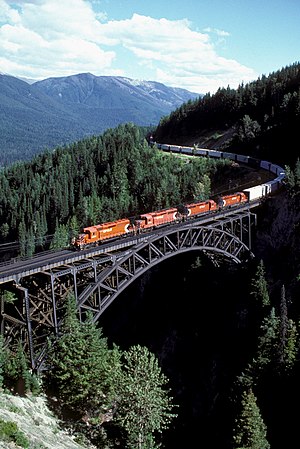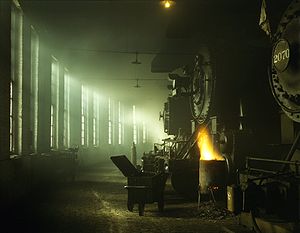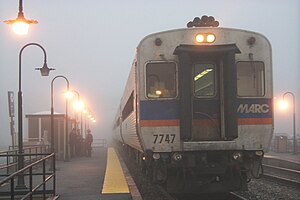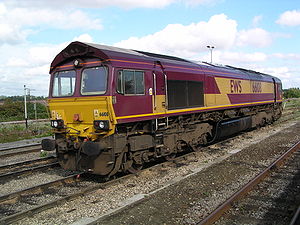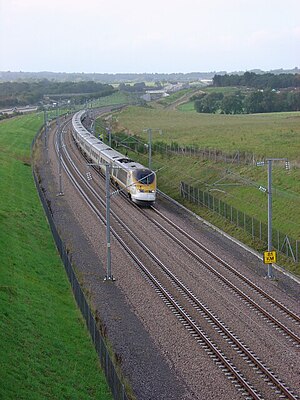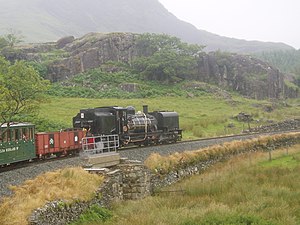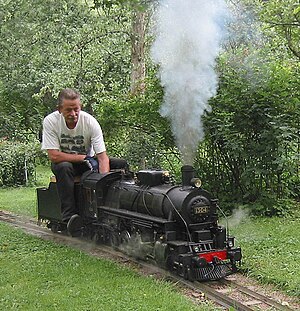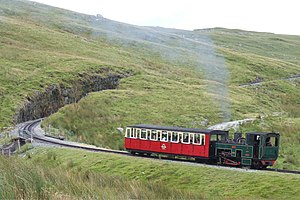Portal:Trains/Featured picture/2005 archive
This is an archive of images that have appeared in the Featured picture section of Portal:Trains in 2005. The portal went live on May 17, 2005, so Week 20, 2005, is the first entry.
A Canadian Pacific Railway (CPR) freight eastbound over the Stoney Creek Bridge. The Stoney Creek Bridge is just within the East end of Glacier National Park on the Connaught track between Rogers and Flat Creek, British Columbia, Canada, on the Mountain Sub of the Revelstoke Division of the CPR. Stoney Creek Bridge is over 600 ft (183 m) long and 325 ft (99 m) above the creek.
Kievskaya station on the Moscow Metro. The Moscow Metro in Moscow, Russia, is the world's most heavily used metro system (see List of metro systems). It is well known for the ornate design of many of the stations, containing stunningly beautiful examples of socialist realist art.
Recently featured: Canadian Pacific Railway
Steam locomotives of the Chicago and North Western Railway in the roundhouse at the Chicago, Illinois, rail yards in December 1942.
A roundhouse is a maintenance facility used by railroads. Roundhouses are the large, circular or semicircular structures that are located surrounding or adjacent to turntables. The roundhouse in a railroad yard is typically where steam locomotives were stored when they weren't in use.
Recently featured: Moscow Metro - Canadian Pacific Railway
The Super Chief passenger train making a stop in Albuquerque, New Mexico, in March 1943. Note that the locomotives are being fueled from tank cars as steam locomotives were still more common at this date.
The streamlined Super Chief was the first diesel-powered, all-Pullman sleeping car train in America, and it eclipsed the Chief as Santa Fe's standard bearer. The extra-fare Super Chief made its maiden run from Dearborn Station in Chicago on May 18, 1937, and covered the 2,225 miles (3,581 km) to Los Angeles over recently-upgraded tracks in just 39 hours and 45 minutes (often exceeding 100 mph / 161 km/h in the process).
Recently featured: Roundhouse - Moscow Metro - Canadian Pacific Railway
A rotary snowplow from the Oregon Short Line (a predecessor of the Union Pacific Railroad) on display at the Mid Continent Railway Museum in North Freedom, Wisconsin.
A rotary snowplow is a piece of railroad snowfighting equipment. It is characterized by the large circular set of blades on its front end that rotate as a unit to cut through the snow on the track ahead of it. The rotary was invented by a Canadian dentist in 1869, but a working prototype wasn't built until the Leslie Brothers constructed one in 1883. Wedge snowplows were the traditional automated method of clearing snow from railroad tracks. These pushed snow off the tracks, deflecting it to the side. Deeper drifts, however, cannot be easily cleared by this method; there is simply too much snow to be moved. For this purpose, the rotary snowplow was devised.
Recently featured: Super Chief - Roundhouse - Moscow Metro
A Virgin Trains high speed train passes Dawlish, England, on the former Great Western Railway.
The Great Western Railway (GWR) was a British railway company, linking South West England, the West Country and South Wales with London. It was founded in 1833, kept its identity through the 1923 grouping, and became part of British Railways at nationalisation in 1948. Known to some as God's Wonderful Railway or the Great Way Round, it gained great fame as the "Holiday Railway", taking huge numbers of people to resorts in the South-West.
Recently featured: Rotary snowplow - Super Chief - Roundhouse
Gare Montparnasse is a train station located in the Montparnasse area, in the XIVe arrondissement of Paris, France.
On October 22, 1895, the Granville-Paris Express overran the buffer stop. The locomotive careened across almost 100 feet (30 meters) of the station concourse, crashed through a two-foot thick wall, shot across a terrace and sailed out of the station, plummeting onto the Place de Rennes 30 feet (10 meters) below where it stood on its nose.
Recently featured: Great Western Railway - Rotary snowplow - Super Chief
The only preserved LMS Stanier Mogul, former London, Midland and Scottish Railway number 2968.
The Stanier Mogul is a class of 2-6-0 mixed traffic steam locomotive. 40 were built between 1933 and 1934. They were developed from the LMS Hughes Crab 2-6-0 with the addition of several features brought over from the Great Western Railway by newly-arrived Chief Mechanical Engineer William Stanier, most notably the taper boiler. This locomotive type was removed from service between 1963 and 1967, with only one preserved.
Recently featured: Gare Montparnasse - Great Western Railway - Rotary snowplow
Exterior view of New York City's Penn Station, circa 1911.
Pennsylvania Station is one of New York City's main railway stations. Commonly known as Penn Station, it is located in the underground levels of Pennsylvania Plaza, an urban complex located at 32nd Street between 7th and 8th Avenues in Manhattan. Madison Square Garden is located atop the station. Penn Station is located at the center of the Northeast Corridor, an electrified passenger railroad line extending from Washington, DC, to Boston, Massachusetts. The station is served by a number of passenger rail services including Amtrak (the station's owner), Long Island Rail Road, New Jersey Transit, and the New York City Subway System.
Recently featured: LMS Stanier Mogul - Gare Montparnasse - Great Western Railway
- This image has been deleted
Electric multiple unit trains of the PKP await service in Poznan, Poland.
A multiple unit is a passenger train whose carriages have their own motors, either diesel ("DMUs") or electric ("EMUs"), and do not need to be hauled by a locomotive. The driver's cab on an MU is usually truncated to a short room at both ends of the train.
Recently featured: Pennsylvania Station - LMS Stanier Mogul - Gare Montparnasse
A MARC train on a foggy morning at Brunswick, Maryland.
MARC (formerly Maryland Rail Commuter Service) is a commuter rail system comprising three lines in the Baltimore-Washington Metropolitan Area. MARC is administered by the Maryland Transit Administration (MTA), a Maryland Department of Transportation agency, and is operated under contract with CSX Transportation and the National Railroad Passenger Corporation (Amtrak). The Brunswick Line is MARC's longest line, stretching from Washington, DC, to Martinsburg, West Virginia.
Recently featured: Electric multiple unit - Pennsylvania Station - LMS Stanier Mogul
A train of the Montenvers Railway passes the Mer de Glace July 2003.
The Montenvers Railway or Chemin de fer du Montenvers is a mountain railway line in the Haute-Savoie region of France. The line runs from a connection with the SNCF, in Chamonix, to the Hotel de Montenvers station, at the Mer de Glace, at an altitude of 1,913 m (6,276 ft). The line is 5.1 km (3.2 mi) long and has a rail gauge of 1 m (3 ft 3.37 in). It is a rack and adhesion railway, using the Strub design to overcome a height difference of 871 m (2,858 ft).
Recently featured: Maryland Rail Commuter Service - Electric multiple unit - Pennsylvania Station
A westbound Southern Pacific Railroad freight train leaves Chicago on October 6, 1992.
The Southern Pacific Railroad (reporting mark SP) was an American Class I railroad. The railroad was founded as a land holding company in 1865, forming part of the Central Pacific Railroad empire. By 1900, the Southern Pacific Company had grown into a major railroad system that incorporated a lot of smaller companies and that extended from New Orleans through Texas to El Paso, across New Mexico and through Tucson, Arizona, to Los Angeles, throughout most of California including San Francisco and Sacramento; it absorbed the Central Pacific Railroad extending eastward across Nevada to Ogden, Utah, and had lines reaching north throughout and across Oregon to Portland. On August 9, 1988, the Interstate Commerce Commission approved the purchase of the Southern Pacific by Rio Grande Industries, the company that controlled the Denver & Rio Grande Western Railroad. The Rio Grande officially took control of the Southern Pacific on October 13, 1988. After the purchase, the combined railroad kept the Southern Pacific name due to its brand recognition in the railroad industry and with customers of both constituent railroads.
Recently featured: Montenvers Railway - Maryland Rail Commuter Service - Electric multiple unit
Class 66 66108 at Didcot on 23 August 2004. These locomotives operate the majority of EWS freight trains.
English, Welsh and Scottish Railway (EWS), then a subsidiary of Wisconsin Central, bought most of British Rail's privatised freight operations. The locomotives that EWS inherited were at the end of their useful lives. EWS therefore went to General Motors' Electro Motive Diesel division (EMD), who offered their JT42CWR model, a development of the Class 59. 250 were ordered and were built in Canada in London, Ontario.
Recently featured: Southern Pacific Railroad - Montenvers Railway - Maryland Rail Commuter Service

A train of the Semmering Railway is dwarfed by the Austrian Alps.
The Semmering Railway, in Austria, which starts at Gloggnitz and leads over the Semmering to Mürzzuschlag, is commonly referred to as the world's first mountain railway. It was the first mountain railway in Europe built with standard gauge track, and is still fully functional. The Semmering Railway is part of the Austrian Southern Railway.
Recently featured: British Rail Class 66 - Southern Pacific Railroad - Montenvers Railway
Week 35: August 28-September 3
Somerset and Dorset Joint Railway class 7F 2-8-0 number 53809 on the Ludgershall branch, 26 September 1987.
Eleven class 7F locomotives were built in two batches in 1914 (numbers 80 through 85) and 1925 (86 through 90). Through mergers and reorganizations, the locomotives eventually ended up on British Railways as numbers 53800 through 53810. They remained in service until the 1960s; two of them survive in preservation, number 88 (BR number 53808) and 89 (53809).
Recently featured: Semmering Railway - British Rail Class 66 - Southern Pacific Railroad
Week 36: September 4-September 10
Passengers waiting for the first trains of the day at the Indian Railways train station in Varanasi.
A train station, or railroad station (American English), or railway station (British English), is a point of call for trains, allowing the loading or unloading of goods, or allowing passengers to board and alight. Early stations were usually built with both passenger and goods facilities. This dual purpose is less common today, and in many cases goods facilities are restricted to major stations.
Recently featured: S&DJR 7F 2-8-0 - Semmering Railway - British Rail Class 66
Week 37: September 11-September 17
A Eurostar train travels High Speed 1.
Eurostar is a train service that connects London with Paris and Brussels. Trains cross the English Channel via the Channel Tunnel. The French and Belgian sections of the route use the same high-speed rail lines as the TGV and Thalys, and in England a new line, High Speed 1, is being built to the same standard. This is a two-phase project known as the Channel Tunnel Rail Link project (CTRL).
Recently featured: Varanasi train station - S&DJR 7F 2-8-0 - Semmering Railway
Week 38: September 18-September 24
Atchison, Topeka and Santa Fe Railway 2-10-4 steam locomotive number 5000, "Madam Queen".
"Madam Queen" proved the viability of the 2-10-4 type on the Santa Fe, but the Great Depression shelved plans to acquire more. In 1938, with the railroad's fortunes improving, the Santa Fe acquired ten locomotives; these were ordered with 74 in (1.88 m) drivers and 310 lbf/in² (2.1 MPa) boiler pressure, making the Santa Fe 2-10-4s the fastest and most modern of all. Of the original order of ten, five were oil-burning and five coal-burning; when the Santa Fe ordered 25 more for 1944 delivery, all were delivered equipped to burn oil.
Recently featured: Eurostar on CTRL - Varanasi train station - S&DJR 7F 2-8-0
Week 39: September 25-October 1
A spiker in operation near Prairie du Chien, Wisconsin.
A spiker is a piece of railroad maintenance of way equipment. Its purpose is to drive railroad spikes into the ties on a railroad track to hold the rail in place. Many different sizes of spikers are manufactured and in use around the world.
Recently featured: Santa Fe 5000 "Madam Queen" - Eurostar on CTRL - Varanasi train station
Welsh Highland Railway garratt (ex-South African Railways no 143) in the Welsh countryside.
The Welsh Highland Railway ran from Dinas near Caernarvon to Porthmadog, with a branch line to the slate mines at Bryngwyn. The railway was not a commercial success and went into receivership in 1927. The service continued, operated by the Ffestiniog Railway Company, until 1936. After only ten years of operation the longest narrow gauge railway in Wales closed, and the tracks were lifted during scrap collections in World War II.
Recently featured: Spiker - Santa Fe 5000 "Madam Queen" - Eurostar on CTRL
Week 41: October 9-October 15
Deutsche Bundesbahn on a snowy day.
Deutsche Bundesbahn was formed September 7, 1949 as the successor of the Deutsche Reichsbahn-Gesellschaft (DRG) in the American and British zones, and of the Süddeutsche Eisenbahn in the French zone of West Germany.
Recently featured: Welsh Highland Railway - Spiker - Santa Fe 5000 "Madam Queen"
Week 42: October 16-October 22
Rail tracks and mechanical semaphore signals in the background.
Rail tracks are used on railways, which, together with railroad switches (points), guide trains without the need for steering. Tracks consist of two parallel steel rails, which are laid upon sleepers (or cross ties) embedded in ballast to form the railroad track. The rail is fastened to the sleepers with rail spikes for wooden sleepers or Pandrol clips for cement or concrete sleepers.
Recently featured: Deutsche Bundesbahn - Welsh Highland Railway - Spiker
Week 43: October 23-October 29
The waiting room of Chicago Union Station in 1943.
Union Station opened in 1925, replacing an earlier 1881 station, and is now the only intercity rail terminal in Chicago. Union Station was built on the west side of the Chicago River and stands between Adams Street and Jackson Street. It is, including approach and storage tracks, about nine and a half city blocks in size, mostly underground. The Chicago Union Station Company, now a subsidiary of Amtrak, owns the station.
Recently featured: Rail tracks - Deutsche Bundesbahn - Welsh Highland Railway
Week 44: October 30-November 5
Preserved British Railways 73129, a Standard Class 5MT 4-6-0 takes on coal at Swanick May 22, 2005.
The British Railways Standard Class 5MT 4-6-0 was one of the standard classes of steam locomotives built by British Railways in the 1950s. The first of the class, number 73100, was outshopped from Derby in April 1951 and 30 were in service by January 1952. 172 were built, essentially being a development of the LMS black five. Five of this class have been preserved, including number 73129 at the Midland Railway Centre in Derbyshire.
Recently featured: Chicago Union Station - Rail tracks - Deutsche Bundesbahn
Week 45: November 6-November 12
92220 Evening Star, the last steam locomotive built by British Railways.
Evening Star was built in Swindon in 1960. She was given a special livery of passenger green, unlike other members of her class of heavy freight locomotive which were painted black, and named Evening Star after a previous locomotive on the Great Western Railway and consistent with the naming of the BR standard class 7's. Although steamed since her retirement from BR, Evening Star is currently a static exhibit at the National Railway Museum, York.
Recently featured: BR Standard Class 5MT - Chicago Union Station - Rail tracks
Week 46: November 13-November 19
Union Pacific Railroad 9214, a GE Dash 8-40C, leads an eastbound train up California's Cajon Pass on May 10, 1991.
Union Pacific Railroad is the largest railroad in the United States. Its primary AAR reporting mark is UP. Union Pacific's route map covers most of the central and western United States, west of Chicago and New Orleans. It has achieved this size thanks to purchasing a large number of other railroads; notable purchases include Missouri Pacific (1982), Western Pacific (1983), Missouri–Kansas–Texas (1988), Chicago and North Western (1995), and Southern Pacific (1996) railroads. Union Pacific's chief competitor is BNSF Railway, which covers much of the same territory.
Recently featured: BR 92220 Evening Star - BR Standard Class 5MT - Chicago Union Station
Week 47: November 20-November 26
- No Portal:Trains Featured picture was selected for this week. Part of the problem was the difficulty in viewing images due to technical problems. See November 2005 image server for more information
Recently featured: Union Pacific Railroad - BR 92220 Evening Star - BR Standard Class 5MT
Week 48: November 27-December 3
A brakeman on the Indiana Harbor Belt Railroad uses a fusee to demonstrate a hand signal indicating "stop".
A fusee is a pyrotechnic device similar to an automotive flare that is used as a signaling device on North American railroad lines. Since a fusee can only be used once, it is normally reserved for emergency use only.
Recently featured: Union Pacific Railroad - BR 92220 Evening Star - BR Standard Class 5MT
Week 49: December 4-December 10
A live steam model builder operating the locomotive he built.
Ridable, large scale live steam railroading on a backyard railroad is an increasingly popular, but time-consuming and/or expensive hobby. Garden railways, in smaller scales, offer the excitement of real steam engines, but at lower cost, and in less space.
Recently featured: Fusee - Union Pacific Railroad - BR 92220 Evening Star
Week 50: December 11-December 17
A collection of diesels and operators at Bristol Temple Meads. From left to right: Wessex Trains British Rail Class 143 DMU 143619; EWS Class 66 locomotive 66049; a Class 158 DMU operated by Arriva Trains Wales; an unidentified First Great Western Class 43 HST powercar.
Bristol Temple Meads is situated about a mile south-east of the city centre in Bristol, England, and is the main station for central Bristol. Bristol's other main-line station, Bristol Parkway, is situated on the northern outskirts of the town. Due to the layout of the lines around the station, trains to Wales, the midlands, the north, London and down to the south coast all exit out the east end of the station. Only trains heading on the line down to Cornwall exit out the west end. The curved train shed is 500 ft (154 m) long on the platform edge and has a wrought-iron roof structure by engineer Francis Fox. It replaced the 1844 station of the Bristol and Exeter Railway, which was perpendicular to the Great Western Railway station.
Recently featured: Live steam - Fusee - Union Pacific Railroad
Week 51: December 18-December 24
LRVs of the Sacramento Regional Transit District, commonly referred to as the RT, being prepared for departure on May 9, 1991.
The RT operates a 30.3 mile (48.8 km) light rail system. The first line, Watt/I-80-Downtown-Meadowview, which opened in 1987, was an 18.3 mile (29.5 km) route between the northeast, the downtown core, and the east. The line was mainly built using an existing railroad right-of-way, coupled with use of structures of an abandoned freeway project. A limited amount of the route runs on streets, mainly in downtown Sacramento.
Recently featured: Bristol Temple Meads station - Live steam - Fusee
Week 52: December 25-December 31
A train on the Snowdon Mountain Railway descends the grade.
The Snowdon Mountain Railway (Welsh: Rheilffordd yr Wyddfa) is a narrow gauge rack and pinion mountain railway in Wales. The line is a tourist railway that travels for 7.5 km (5 miles) to the summit of Snowdon, the highest peak in Wales. It is the only public rack railway in the British Isles and after more than a hundred years of service, it remains a highly popular tourist attraction. It is operated by a mixture of steam locomotives, diesel locomotives, and diesel railcars.
Recently featured: Sacramento Regional Transit District - Bristol Temple Meads station - Live steam

